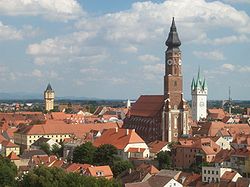Straubing
Straubing | |
|---|---|
 View of Straubing. | |
| Country | Germany |
| State | Bavaria |
| Admin. region | Niederbayern |
| District | Urban district |
| Government | |
| • Mayor | Markus Pannermayr (CSU) |
| Area | |
• Total | 67.58 km2 (26.09 sq mi) |
| Elevation | 322 m (1,056 ft) |
| Population (2023-12-31)[1] | |
• Total | 49,775 |
| • Density | 740/km2 (1,900/sq mi) |
| Time zone | UTC+01:00 (CET) |
| • Summer (DST) | UTC+02:00 (CEST) |
| Postal codes | 94301–94315 |
| Dialling codes | 09421 |
| Vehicle registration | SR |
| Website | www.straubing.de |
Straubing is an independent city in Lower Bavaria, southern Germany. It is seat of the district of Straubing-Bogen. Annually in August the Gäubodenvolksfest, the second largest fair in Bavaria, is held.
The city is located on the Danube forming the centre of the Gäuboden.
History


The area of Straubing has been continuously settled since the Neolithic. The conquest by the Romans in 16–14 BC had a dramatic impact on the whole region. Even today many traces of the 400-year Roman occupation can be found: for example, the famous 'Römerschatz' (Roman treasure) which is shown in the Gäubodenmuseum. Sorviodurum, as the Romans called it, was an important military support base.
After the fall of the Roman Empire Straubing became a centre of settlement of the Bavarii, mostly around St. Peter's Church (built in the 9th century) between Allachbach and Danube. According to the customs of the Bavarii the settlement was named after their leader Strupinga, which later evolved into the name Straubing.
1218 a new part of the city (called 'new town') was founded by Duke Ludwig I Wittelsbach of Bavaria. Straubing became the capital of the Duchy of Bavaria-Straubing under Duke Wilhelm I when Bavaria was divided among the sons of Louis IV, Holy Roman Emperor in 1349. In 1429 Straubing passed to Ernest, Duke of Bavaria-Munich, who ordered the murder of Agnes Bernauer in Straubing. The grave of Agnes Bernauer cannot be found. But in the graveyard of St. Peter's Church is a chapel built by Duke Ernest.
Nowadays, this new town is the centre of Straubing with many shops, offices, restaurants and a pedestrian area. Most buildings there still have medieval style. The nightlife of Straubing, with many pubs and discothèques, is concentrated in this area.
The most important buildings are the beautiful Gothic cathedral-like Basilica of St. Jacob, the Romanesque St. Peter's Church, the Carmelite monastery with its Baroque church and library, St. Vitus's, where you can find a life-size personification of "state and church" joined in holy matrimony.
Between 1933 and 1945 most of the members of the then small Jewish community of Straubing were murdered or forced to emigrate. In 2006, Straubing had a lively Jewish community with around 950 members.
During a rally in June 1940, when Straubing and Bogen held its Kriegskreistag, some 20,000 people gathered at the Großdeutschlandplatz. Among the speakers were Gauleiter Wächtler and Gauamtsleiter Erbersdobler.[2] In July 1940, the Donau-Zeitung reported that the Straubing Kreisleiter, Anton Putz, had flown toward France and not returned.[3]
In 1944 and 1945, Straubing suffered from several American air raids. The local military hospital was destroyed to the extent of 80 percent with a loss of 45 patients.
Straubing also has many industrial areas and a port at the river Danube with access to the Rhine-Main-Danube Canal, a connection from the North Sea to the Black Sea. It is the centre of the Bavarian high tech offensive in biotechnology.
Main sights
As one of five ducal residences of medieval Bavaria (besides Landshut, Munich, Ingolstadt and Burghausen) the old town of Straubing especially features many Gothic buildings.



- The Romanesque Church of St. Peter (12th century) [1]
- The Gothic City tower (begun in 1316) [2] [3]
- The Gothic town hall
- The medieval ducal castle or Herzogsschloss (begun in 1356) [4]
- The Gothic Basilica of St. Jacob (present-day church begun in 1393) [5]
- The Church of St. Vitus (St. Veit) – home of the oldest still existing confraternity in Germany, the St. Salvator-Confraternity [6]
- The Carmelite monastery and Church of the Holy Spirit (since 1368, by Hans von Burghausen; the only monastery which survived the dissolution of 1802) The monks especially support Palestinian Christians. [7]
- Church of St.Ursula (Ursulinenkirche) by the Asam brothers
- The Baroque Trinity Column at Theresienplatz
- The Water Tower
- Sossau pilgrimage church
- Straubing Zoo (the only zoo in East Bavaria)
Festivals and main cultural events
- Straubinger Frühlingsfest – a spring festival(annual)
- Gäubodenvolksfest and Ostbayernschau
- Museum containing Roman artifacts.
- Agnes-Bernauer-Festspiele – a historical play to remind of the murdered Agnes Bernauer
- Straubing Zoo
- A Jazz festival – Jazz an der Donau – one of the greatest jazz-festivals in Europe with special guests like Seal, Aretha Franklin or Mousse T. (annual)
- Bürgerfest (burgher festival) is held every two years in the historical centre of Straubing
Historical residents
- Agnes Bernauer
- Mathias Flurl
- Joseph von Fraunhofer
- Jakob Sandtner
- Emanuel Schikaneder
- Ulrich Schmidl
- Carl Spitzweg
Sports
- Ice hockey: Straubing Tigers – DEL (Highest German League)
- American Football: Straubing Spiders – founded in 1985
- Harness Racing: Trabrennbahn Straubing (Highest German Level)
Education
Straubing has four "Gymnasiums" (German for grammar school):[4]
- Anton-Bruckner-Gymnasium
- Gymnasium der Ursulinen
- Johannes-Turmair-Gymnasium
- Ludwigsgymnasium
International relations
Straubing is twinned with:
References
- ^ Genesis Online-Datenbank des Bayerischen Landesamtes für Statistik Tabelle 12411-003r Fortschreibung des Bevölkerungsstandes: Gemeinden, Stichtag (Einwohnerzahlen auf Grundlage des Zensus 2011).
- ^ Anna Rosmus Hitlers Nibelungen, Samples Grafenau 2015, pp. 247f
- ^ Anna Rosmus Hitlers Nibelungen, Samples Grafenau 2015, pp. 261f
- ^ "Schulen". Adressenverzeichnisse. Stadt Straubing. Retrieved 26 January 2013.
External links
![]() Media related to Straubing at Wikimedia Commons
Media related to Straubing at Wikimedia Commons


